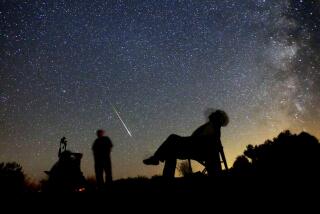Cannon Boosts Theory That Meteorite Did In Dinosaurs
- Share via
Two Caltech scientists who experimented with a 50-foot “gun” to simulate the impact of a giant meteorite on prehistoric Earth have concluded that such a collision could have raised temperatures enough to have killed off the dinosaurs.
Research by planetary scientist John D. O’Keefe and geophysicist Thomas J. Ahrens suggest that if a meteorite or comet 10 miles in diameter struck limestone or sedimentary rock similar to that found in shallow parts of the ocean 65 million years ago, it would have released two to five times as much carbon dioxide as was already present in the atmosphere.
The carbon dioxide would have produced a “greenhouse effect,” trapping heat that would otherwise have radiated into space and warming the Earth’s surface by about 20 degrees in as little as 10 days, they said. The increased heat would have killed off many of the dinosaurs as well as the leafy plants they fed on, leading to the dinosaurs’ gradual extinction, they said.
Latest Explanation
The Ahrens and O’Keefe theory, which they are scheduled to present today at the Lunar and Planetary Science Conference in Houston, is the latest attempt to explain how the impact of a meteorite could have triggered the disappearance of the dinosaurs. Unlike most others, however, this was based on laboratory experiments.
Other scientists praised the new theory. “We are quite confident that . . . it was a temperature rise that caused the death of the dinosaurs and other animals,” said marine geologist Cesare Emiliani of the University of Miami. “This is a good cause for the temperature rise.”
But geologist Erle G. Kauffman of the University of Colorado cautioned that, although the new theory is plausible, neither of the two best candidates for the site of the presumed meteor impact--one in Iowa and one in India--have substantial amounts of limestone.
But another potential impact site off the Pacific Coast of the United States would have had significant sedimentary deposits. “I think it is a factor that definitely has to be considered,” said geochemist Frank Kyte of UCLA.
Fascinating Subject
Mankind has long been fascinated with dinosaurs, which dominated the world for 160 million years until they abruptly disappeared 65 million years ago--along with as many as 50% of the other species alive at that time. This episode figuratively cleared the way for the subsequent rise of mammals.
A surge of interest in this extinction event arose in 1980 when physicist Luis Alvarez and his son, geologist Walter Alvarez, of UC Berkeley found evidence that a large meteorite struck the Earth about the same time that dinosaur fossils disappeared from the geological record.
They speculated that large amounts of dust and smoke from the collision were swept into the atmosphere, blocking sunlight and causing a period of darkness and cold that killed the dinosaurs. Scientists have since speculated that a similar “nuclear winter” would follow an atomic war.
Most scientists now agree that a meteorite did, in fact, strike, but there is a great dispute over whether it caused the extinctions and, if so, how.
Cannons Welded Together
O’Keefe and Ahrens approached the problem by attempting to mimic the effects of a meteorite strike. They welded together three naval cannon barrels to form the gun that fired half-inch-diameter tungsten and aluminum pellets at rocks at speeds as high as 13,500 m.p.h. The gun used compressed gas to fire the pellets.
They observed that the impact released large amounts of carbon dioxide that had been part of the chemical structure of the rocks. That, in turn, could be expected to raise temperatures. Scaling up from their results, they concluded that a meteorite 6 miles in diameter544698229degrees Fahrenheit, while one 30 miles in diameter would lead to an increase of 36 degrees.
“An almost instantaneous increase of between 9 and 36 degrees would have unimaginably dire consequences for all life on Earth,” O’Keefe said in a telephone interview. That temperature increase could have persisted for up to 10,000 years, he said.
“There might have been a nuclear winter for a few weeks that killed some of the dinosaurs,” Emiliani said, “but the cause of the extinction was more likely the ‘nuclear summer’ that followed.”
Explanation Questioned
Kyte agrees that the greenhouse effect could have played a role in the extinctions, “but I don’t think anyone could demonstrate that any one factor is the most important.” The extinction, he said, was most likely “the cumulative result of numerous different insults to the environment.”
Scientists believe a similar but less severe greenhouse effect is occurring today as carbon dioxide is released into the atmosphere by the burning of fossil fuels. Some researchers believe that global temperatures could increase by as much as 9 degrees Fahrenheit by the middle of the next century as a result.






